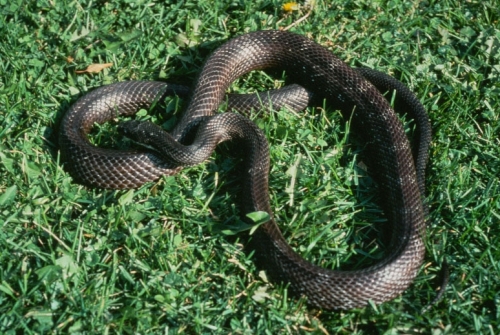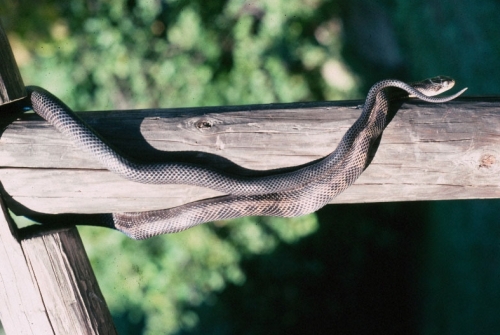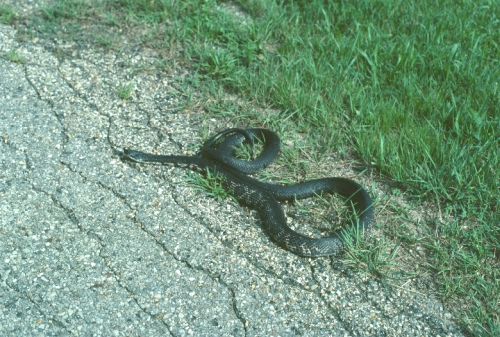Plants and Animals
Pantherophis spiloides Gray rat snake
Key Characteristics
The Gray Ratsnake is the largest snake in the Great Lakes region, with total adult lengths ranging from 40-101 inches (102-257 cm). Adult Gray Ratsnakes are black or dark brown in color often with remnant dark blotches from their juvenile color pattern. The belly is white or yellow with dark checkerboard markings on the forward part of the body becoming gray or brown toward the mid-body or tail. The labial scales ("lips"), chin and throat are also white. The young are yellow, white or pale gray in color and strongly patterned, with dark gray or brown blotches or saddles on their backs alternating with smaller blotches on the sides.
Status and Rank
US Status: No Status/Not Listed
State Status: SC - Special Concern (rare or uncertain; not legally protected)
Global Rank: G4G5 - Rank is uncertain, ranging from apparently secure to secure
State Rank: S2S3 - Rank is uncertain, ranging from imperiled to vulnerable
Occurrences
| County | Number of Occurrences | Year Last Observed |
|---|---|---|
| Allegan | 4 | 2023 |
| Barry | 2 | 2024 |
| Berrien | 12 | 2022 |
| Cass | 5 | 2022 |
| Clinton | 2 | 2022 |
| Eaton | 1 | 2022 |
| Genesee | 1 | 2020 |
| Hillsdale | 1 | 1985 |
| Jackson | 1 | 1985 |
| Kalamazoo | 3 | 2024 |
| Lenawee | 2 | 1999 |
| Livingston | 1 | 2023 |
| Muskegon | 4 | 2024 |
| Newaygo | 1 | 2024 |
| Oakland | 1 | 1992 |
| Ottawa | 2 | 2024 |
| Saginaw | 1 | 1995 |
| St. Joseph | 1 | 2020 |
| Tuscola | 1 | 2007 |
| Van Buren | 4 | 2019 |
| Washtenaw | 2 | 2023 |
Information is summarized from MNFI's database of rare species and community occurrences. Data may not reflect true distribution since much of the state has not been thoroughly surveyed.
Habitat
Gray Ratsnakes usually occur in forested habitats, primarily deciduous forests, but they also use adjacent open habitats including shrubby fields, prairies and marsh and bog edges. Gray Ratsnakes also are often found in or around barns, outbuildings, old foundations and trash dumps. The Gray Ratsnake is a very good climber and often climbs trees to eat nestling birds or eggs. Gray Ratsnakes hibernate in mammal burrows, root networks, rock crevices or other burrows or crevices that provide refuge from freezing temperatures. Gray Ratsnakes deposit eggs in loose soil, rotted stumps or logs, sawdust piles or cavities under rocks, boards or other cover.
Specific Habitat Needs
Downed woody debris needed in: Bog; Dry sand prairie; Dry southern forest; Dry-mesic prairie; Dry-mesic southern forest; Emergent marsh; Mesic prairie; Mesic sand prairie; Mesic southern forest; Oak barrens; Oak openings; Wet-mesic sand prairie.
Natural Community Types
- Bog
- Dry sand prairie
- Dry southern forest
- Dry-mesic prairie
- Dry-mesic southern forest
- Emergent marsh
- Mesic prairie
- Mesic sand prairie
- Mesic southern forest
- Oak barrens
- Oak openings
- Wet-mesic sand prairie
For each species, lists of natural communities were derived from review of the nearly 6,500 element occurrences in the MNFI database, in addition to herbarium label data for some taxa. In most cases, at least one specimen record exists for each listed natural community. For certain taxa, especially poorly collected or extirpated species of prairie and savanna habitats, natural community lists were derived from inferences from collection sites and habitat preferences in immediately adjacent states (particularly Indiana and Illinois). Natural communities are not listed for those species documented only from altered or ruderal habitats in Michigan, especially for taxa that occur in a variety of habitats outside of the state.
Natural communities are not listed in order of frequency of occurrence, but are rather derived from the full set of natural communities, organized by Ecological Group. In many cases, the general habitat descriptions should provide greater clarity and direction to the surveyor. In future versions of the Rare Species Explorer, we hope to incorporate natural community fidelity ranks for each taxon.
Management Recommendations
Protecting known populations and maintaining large, contiguous forested habitat complexes or mosaics of forested and open habitats are essential for conservation of this species. These snakes rapidly disappear with deforestation, but they may persist in patches of forest. Partial timber harvest techniques and low-intensity agricultural uses that create mosaics of forested and open habitats would benefit this species. Management activities that have potential to cause take or adverse impacts on Gray Ratsnakes (e.g., timber harvesting, use of heavy equipment, mowing) should be conducted when the snakes are inactive or less active (i.e., November to March) to minimize the potential for adverse impacts. To reduce habitat fragmentation and road mortality, construction of new roads through suitable habitat complexes for Gray Ratsnakes should be discouraged or minimized, and closure of existing roads through suitable habitat complexes should be considered. Surveys and research are needed to determine this species' status and distribution and investigate this species' ecology and conservation and management needs in Michigan. Public education also is needed to communicate the harmless nature of this snake, demonstrate the value and benefits of maintaining this species (e.g., its consumption of rodents makes it useful in agricultural areas) and discourage persecution and harassment.
Active Period
Active from fourth week of April to fourth week of October
Breeding from first week of May to second week of June
Nesting from fourth week of June to fourth week of July
Survey Methods
The best time to survey for this species is in May and June during the mating season. An effective way to survey for this species is with funnel traps and drift fences. Drift fences and funnel traps should be placed throughout areas with suitable habitat and should be checked daily or more frequently, if possible, during the survey period. Visual encounter surveys also can be conducted for this species, although they may be difficult to see when they are above ground in tree branches, particularly after leaf out. Visual surveys should be conducted during appropriate weather conditions, generally between 60-80 or 85 degrees F, partly sunny or cloudy skies, and little to no wind.
Trapping with drift fences and funnel traps
Survey Period: From first week of May to fourth week of June
Time of Day: Daytime
Air Temperature: Above 60 degrees
Wind: Light Breeze
Visual encounter surveys
Survey Period: From first week of May to fourth week of June
Time of Day: Daytime
Air Temperature: Above 60 degrees
Wind: Light Breeze
References
Survey References
- Fitch, H.S. 1951. A simplified type of funnel trap for reptiles. Herpetologica 7:77-80.
- Fitch, H.S. 1963. Natural history of the Black Rat Snake (Elaphe o. obsoleta) in Kansas. Copeia 4:649-658.
- Karns, D.R. 1986. Field Herpetology: Methods for the Study of Amphibians and Reptiles in Minnesota. Occ. Pap. No. 18. J.F. Bell Museum of Natural History, University of Minnesota, Minneapolis.
Technical References
- Fitch, H.S. 1963. Natural history of the Black Rat Snake (Elaphe o. obsoleta) in Kansas. Copeia 4:649-658.
- Harding, J.H. 1997.Amphibians and Reptiles of the Great Lakes Region. The University of Michigan Press, Ann Arbor. 378pp.
- Holman, J.A., J.H. Harding, M.M. Hensley and G.R. Dudderar. 1993. Michigan Snakes A Field Guide and Pocket Reference. Michigan State University Extension, East Lansing, MI. 72 pp.
- Minton, S.A. 1972. Amphibians and Reptiles of Indiana. Indiana Academy of Science, Indianapolis. 3: 346pp.




